In the early 1900s, Birkeland and Eyde ionized air into nitric acid, concentrated it and turned it into calcium nitrate for easy transportation. It was inefficient and required large amounts of energy. In the 1910s Haber and Bosch combined natural gas (a by-product of the oil industry) and air under high temperatures and pressure to create ammonia which was further processed into nitrate fertilizers. The process was much less expensive than Berkeland-Eyde and thus became the fertilizer of choice for the next century. In the last 60 years, nitrogen fertilizer usage has grown by 10 times the amount, from 12 million tonnes to over 123 million tonnes per year.

Air
Synthetic fertilizer production is necessary for global food security and population growth, though it contributes to 1.5 gigatons of emissions per year, or 2% of all emissions each year, for generation and application. For every 1 pound of nitrogen produced and applied, a farmer emits 15 pounds of CO2 equivalents.
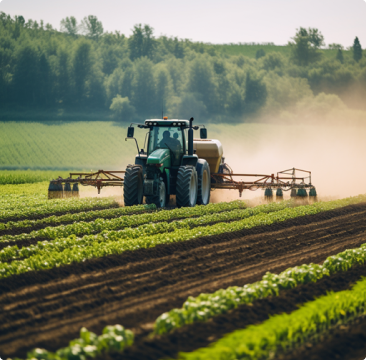
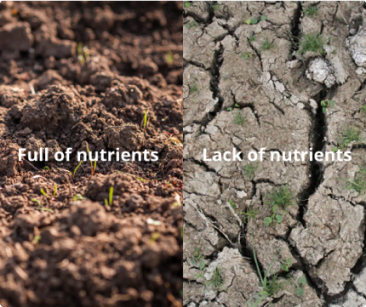
Soil
Nitrogen fertilizers propelled us through the green revolution in the mid 1900s. The more nitrogen you applied, the greater the yield. Only recently have we discovered the unintended consequences of increased yield using fertilizers, the degradation of our soils. Soil is a living synergistic ecosystem that includes billions of microbes, fungi and other living organisms that rely on each other and input from crops. By using fertilizer, which compromises the organism's ability to function (high salt concentrations) and removing the plant life that is absorbing energy from the sun, we are turning our nutrient rich soil into lifeless dirt lacking nutrients that cannot sustain plant growth.
Water
Fertilizer has been cheap over the last 100 years relative to the benefits of increased yield. So it makes sense to use as much as you can afford. Unfortunately, this leads to waste. Fertilizer runoff or leaching has been linked to the nitrification of our waterways and the cause of algae blooms, many of which are toxic. Excessive nitrates (a very water mobile molecule) leaches into the water over, feeding the algae. Algae grow at a much faster rate and take over the ecosystem, consuming all the dissolved oxygen in the water, also known as eutrophication. This leads to the death of marine wildlife and the elimination of the very thing keeping the algae at bay.

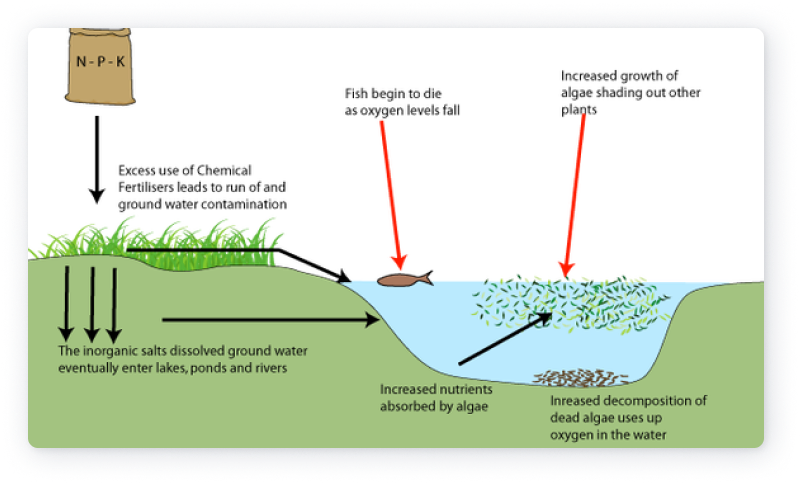
Over the past 20 years, more research has been conducted to determine the effects of synthetic fertilizers on the environment. Here are a few papers and a video to provide more in depth information. Please also use our digital assistant. They are connected to a much more vast knowledge base.
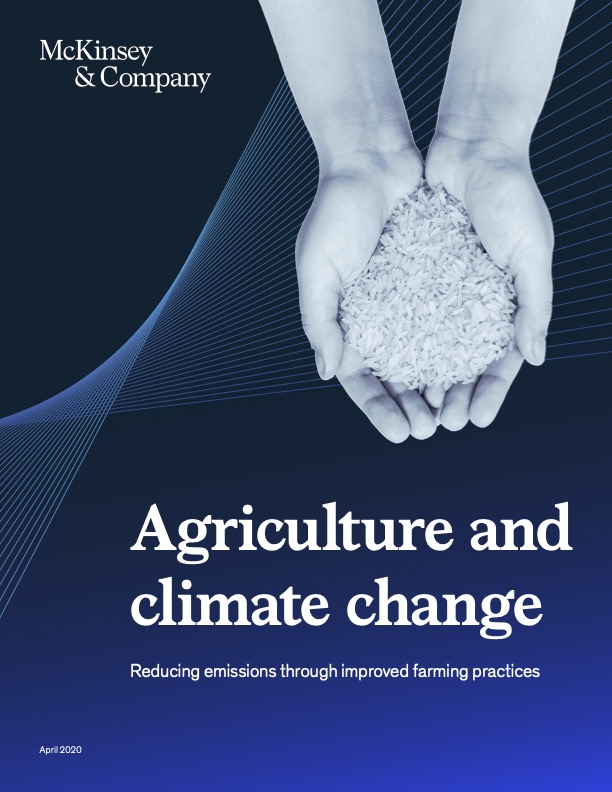
Agriculture and climate change: Reducing emissions through improved farming practices.
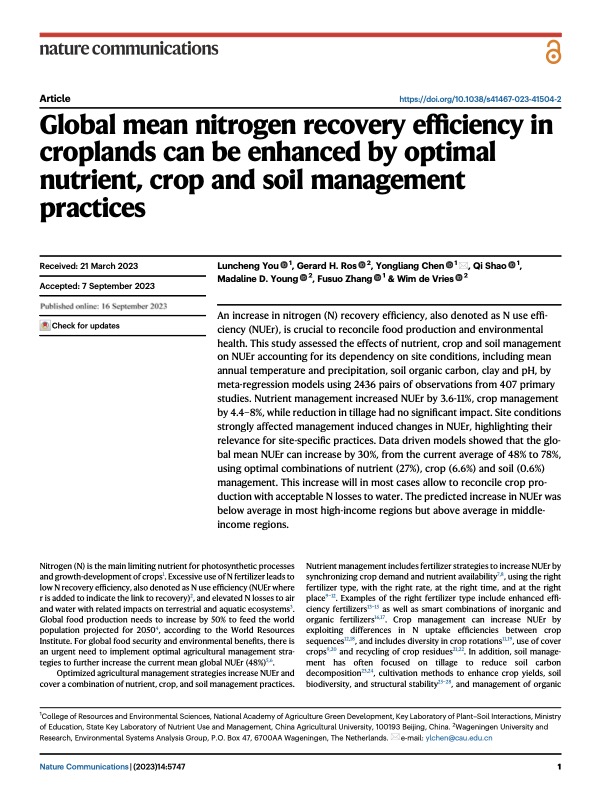
Global mean nitrogen recovery efficiency in croplands can be enhanced by optimal nutrient, crop and soil management practices.
© 2023 NTP Technologies, Inc.
Advisory Board
Julia Inestroza grew up in the fresh produce industry on her family’s citrus, avocado, and olive ranch in central California. After college, she worked in several positions that allowed her to experience and learn the entire fresh food supply chain, from seed to fork. Before returning to her on-the-ground farming roots, she also worked as the Marketing director for a large fresh produce grower, importer/exporter, where she was able to focus on marketing and product/packaging innovation to increase sales and consumption.
Since returning to the ranch, Julia has increased acreage, transitioned some blocks to organic production, and implemented new processes and techniques to remain competitive. In addition to working on her own ranch she has been heavily involved with various citrus industry, agriculture, and community organizations. She currently serves as a member of the USDA Citrus Disease Subcommittee and is also on several water-related committees and boards. Julia also currently serves on the board of directors of Fruit Growers Supply, Sunkist Growers Inc, and California Citrus Mutual.
Julia has a BA in Econ from U.C. Riverside and an MBA with a specialization in technology and operations management from Cal Poly Pomona. She is also a graduate of the California Ag Leadership Program (Class 34) and holds a certification as a Governance Fellow from the National Association of Corporate Directors.
Advisory Board
David Holden has over 45 years of experience working as a Pest Control Advisor and Agricultural Production Consultant who has worked with many crops and has specialty experience working with California avocados, berries, citrus, vegetables, and wine grapes. David is an experienced public speaker, has served on several ag related boards, worked with numerous commissions, and has traveled throughout the country and abroad to present his research.
Holden Research and Consulting (HRC) is owned and operated by David Holden operating in Ventura County, California. HRC conducts many field research projects every year for a variety of agricultural manufacturers in the areas of pest and nutrient management both in the traditional and organic farming areas and has completed over 2000 of these projects to date. In the past ten years, HRC has specialized in research working with biopesticides, biofertilizers, and biostimulants. HRC has also worked with the California Avocado Commission, California Celery Commission, California Pepper Commission, and the University of California.
Advisory Board
Minos Athanassiadis is a Vice President at iFoodDS. He is part of the market leading team which provides SaaS food safety and traceability tools to grower-shippers globally, as well as quality assurance and management tools to top grocery retailers in the US and Australia.
Minos has deep expertise in both the agriculture and technology industries. He has held a series of senior positions with production agriculture companies including Dole Fresh Vegetables and Underwood Ranches. As Managing Director of the advisory firm Fresh Link Group, he led projects for a broad spectrum of clients including Walmart, John Deere, and numerous privately held companies. Minos also serves on the board of AG RX, a leading independent supplier of traditional and organic crop protection and nutrient products.
He is a graduate of the University of California at Davis and the Kellogg School of Management at Northwestern University.
Advisory Board
Chris Berkner is the Founder and CEO of Berkner Group, a leading executive and technical search firm for innovative, high-growth companies in Climate Tech and AgTech.
Chris was formerly Co-founder and Managing Director of One Earth Capital, an early-stage AgTech fund that invested tens of millions of dollars in various AgTech startups (including Marrone Bio, which went public on NASDAQ in 2014). From 2009 to 2012 he was CEO of PureSense, a 50-person AgTech hardware and software company that helped hundreds of large farms save billions of gallons of water while participating in demand response programs with PG&E and SoCal Edison. During his tenure, the company nurtured and formed relationships with a range of agricultural distribution partners including Wilbur Ellis, Helena Chemical, and local irrigation suppliers.
In his more distant past, Chris was VP of Software Engineering at an internet startup, did research on solar nanotechnology at Stanford, and taught karate to kids and adults. In his spare time, Chris enjoys hiking, yoga and playing music.
CEO
John Ireland has held positions as CEO, CFO, COO and Director of Business Development in both private and public corporations in several verticals.
Mr. Ireland currently owns a hydroponics farm in Maryland and along with his own consulting practice, is part of a small consulting group focused on helping colleges and universities with their sustainability and resiliency initiatives.
As part of his consulting practice, Mr. Ireland has worked in many industries assisting companies to prosper. He has been engaged by diverse companies including: a solar thermal company, a privately held software company, an electronics company, an upstream energy transaction exchange, a healthcare leasing company, a medical imaging company, a transaction based marketing company, and a tree seed oil company.
Mr. Ireland has been part of the Clean Tech Open accelerator as a lead mentor for 9 years and was awarded mentor of the year in 2019. He was also the treasure of the MIT Enterprise Forum of CT for 10 years.
One of Mr. Ireland’s notable accomplishments was his tenure as the CFO and COO for Sightlines, a facility benchmarking firm that grew from less than $1 million in revenue to over $7.5 million and was eventually sold for 13x EBITDA.
Mr. Ireland raised startup capital for and was the Founder and CEO of Downstream Energy Corporation. Downstream developed a SaaS solution that provided an alternative to the existing manual business processes and proprietary technologies available to support communication between suppliers and marketers of refined petroleum products.
Mr. Ireland spent eight years at Tosco Corporation in Business Development and Strategic Planning. He was instrumental in the growth of Tosco through mergers and acquisitions from a single refinery to the largest independent oil refiner and marketer in the United States whose assets included 7 refiners and over 5000 retail assets.
Mr. Ireland graduated from Brown University with a bachelor’s degree in chemical engineering and a master’s degree in biochemical engineering. He also holds an MBA from MIT’s Sloan School of Management.
Mr. Ireland sits on several Boards as both a member and an advisor. He was elected to the Board of Education for his local town and was a lacrosse coach for over 12 years.